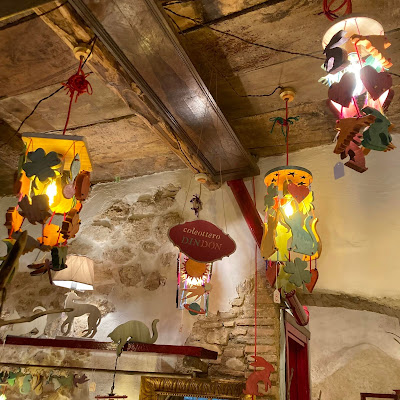 |
| Aerial view of Casperia courtesy of Fabrizio Gherardi |
 |
| Casperia, by Richard Burel |
Hours: Usually open weekends and on holidays
Tel: 342 747 6679
Web: www.richardburelart.com
Facebook: www.facebook.com/richardburelart
Instagram: @richardburelart
Jewellery, Accessories, Arts & Crafts
Tel: 3493935519
E-mail: mrp26358@gmail.com
Facebook: www.facebook.com/laMiaBancarellaRita
Hours: At the time of writing the shop is open on the weekend from Friday to Sunday with continuous hours but still to be defined.
Web: www.coleottero.com
Facebook: www.facebook.com/Coleotterolab
Instagram: @coleotterolab
Hours: Irregular and by appointment
E-mail: loremus@fastwebnet.it
The owner, Loredana Muscatielli, besides selling her handcrafted jewellery and accessories organises and creates everything needed for couples wanting to hold their wedding in Casperia, including bomboniere—traditional Italian wedding favours. People come from as far away as Japan, Russia and Argentina to get married in Casperia.
💚⚪️❤️
Via Tomassoli, 20
Tel: 380 738 6351
E-mail: anteas.casperia@gmail.com
Facebook: www.facebook.com/Anteas.Casperia
Instagram: @anteas_casperia
Via San Rocco, 43
E-mail: orsinibeth@gmail.com
Tel: 338 976 3736
Facebook: www.facebook.com/lacantinadigranburrone

Stefania Pochesci Slow Living
Art, Fashion and Nature Held Together By The Thread Of Kindness
Handcrafted, Cruelty Free Collections for Colourful Souls Made In Italy
Via Cola di Rienzo, 24
Tel: 0765 1897153
Web: www.stefaniapochesci.com/en
Philosophy: The idea naturally stems from the desire to combine eco-sustainability, fashion, graphics and art and at the same time bring it back to the territory and he desire to “create” as an expression of love for nature, design, craftsmanship: art, fashion and nature held together with the thread of kindness.
We create Slow Fashion collections of high manufacturing and design starting from fabrics of vegetable origin, made unique by personalized, eco-sustainable, cruelty-free and Made in Italy designs. The fabrics are vegetable in origin with certified printing. Our production is responsible, our quality is high, our care is infinite,
Packing is kept to a minimum. We believe that the real experience is the product, in fact we have chosen a compostable envelope printed with certified and compostable inks too. With the packaging of cardboard boxes, when necessary, we support reforestation efforts through the “Plant a Tree” project which always ensures to plant more trees than those used to make packaging. The tailoring workshops are all close to Casperia. We promote the work ethic and mutual respect with a view to constructive collaboration with all our collaborators.
Bio: Graduated from the Academy of Fashion and /costume, with a past as a graphic and motion designer for TV, Stefania has a real passion for fabric design. She has a study in the Sabine countryside surrounded by nature and one showroom in Casperia’s medieval historic centre. She believes in the power of dreams and that starting from small actions we can change things for the better and she is convinced that meaningful change can can also start from wardrobes.
💚⚪️❤️
Returning to the black basalt cobbles of Via Tomassoli, take a left turn at the monumental nail-studded wooden door of Palazzo Perrini and half way up the street to your left you will find the studio of the very talented artist, interior decorative painter, fresco restorer and art teacher, Giovanna Somai. Her studio is located in what was once a butcher shop.
 |
| Monte Soratte, by Giovanna Somai |
Studio Arte di Giovanna Sommai
Artist, Visual Arts, Interior Decorative Painting, Jewellery & Painting Lessons
Via Tomassoli, 28
Tel: 333 650 9116
E-mail: giosomai@gmail.com
Web: https://www.flickr.com/photos/giovannasomai/
Facebook: www.facebook.com/giosomaiarte/
Instagram: @giosomai
💚⚪️❤️
Tel: 392 843 4369
E-mail: taormina.marzia@gmail.com
Facebook: www.facebook.com/ceramicandoceramicando/
Instagram: @martao_77
Hours: The atelier is open on weekends and by appointment during the week.
Andrei Nicolae Stroia is a long time resident of Casperia. For years, his whimsical creations mixing painted stream pebbles and wood have been popular among visitors to Casperia's monthly artisans' market at Piazza Umberto I. You will find his art featured inside almost every restaurant, bar and home here in Casperia and many a tourist has carried his whimsical renderings of our little hill town in wood and stone as a souvenir to their homes overseas.




























